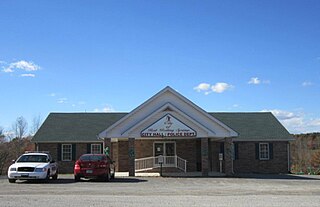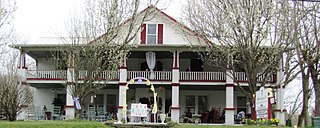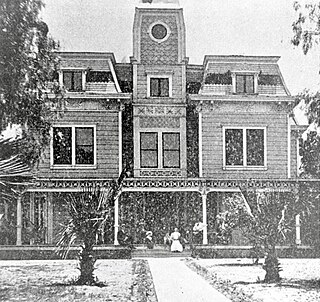
Cartersburg Springs (or Magnetic Springs) is a site in Liberty Township, Hendricks County, Indiana, about a mile north of the town of Carterburg. The springs formerly at the site have ceased flowing.

Cartersburg Springs (or Magnetic Springs) is a site in Liberty Township, Hendricks County, Indiana, about a mile north of the town of Carterburg. The springs formerly at the site have ceased flowing.
Cartersburg Springs (Magnetic Springs) is located at 39°42′32″N86°28′23″W / 39.709002°N 86.473002°W . [1]
The springs were known by and used extensively by Native Americans in the area well before the first white settler, Samuel McCormick and his wife arrived about 1800. Native American artifacts such as arrowheads, and beads, were periodically found near the springs as recently as the 1950s.
Samuel and his wife settled on the hill overlooking the springs near what is now Cartersburg, Indiana, and raised 12 children. According to a 1926 recorded interview with daughter Eliza Jane McCormick, no one in the family ever required the care of a doctor. The family attributed their good health to the healing powers of the spring water.
By the mid-19th century residents of the area would regularly visit the springs to bathe and take home containers of this miracle water.
In 1822, George Matlock, Jacob Wagoner, William Ballard, and Alen Little purchased the farm that surrounded the springs. By the late 19th century the springs had become so popular for picnics and social gatherings that A.W. Carter, G.V. Seaton, J.A. Veatch, John Tartelon, Edward Conn, T.A. Prewitt, and J.A. Dobyn formed the Cartersburg Springs Mineral Corporation with the intent of selling shares and building a resort.
A post in the Danville Union newspaper dated February 19, 1874, states:
A meeting will be held this afternoon at Cartersburg, for the purpose of organizing a joint stock company to erect and conduct a first class hotel at the mineral springs. A lease of these springs has been secured for 21 years. A number of prominent gentlemen have manifested an interest in the project and will be present. W. R. KcKeen, president of the Vandalia RR; Col. Ives of the Bates House; J.R. Morat and others. We wish the enterprise rapid and complete success.
Almost immediately disagreements and disputes erupted, some leading to bitter grudges.
By 1900, the group had spent a tidy sum of money that they didn't have, and they were forced to sell some of the land. One of the stockholders, Albert Veatch, purchased about 70 acres (280,000 m2) including the hill overlooking the springs with the intent of building a competing hotel but that dream never materialized.
An advertisement titled "The Season of 1901" promoted the springs by saying,
Under new management, the hotel, bath house, and everything connected have been refitted and refurnished and will hereafter be run in a manner to make it not only attractive as a health resort, but as a pleasant summer home for those who enjoy rest in the country.
Brochure prices were:
Around 1903 the balance of the Cartersburg Springs Mineral Corporation was purchased by Dr. Kimberlin, a well-known heart specialist. He immediately sold a 49% interest to Armand Koehne and together they pushed the enterprise into a summer hotel success.
A 1903 water analysis report released by the Indiana State Board of Health and signed by the boards director Dr. J.N. Hurty says:
These are very pure and soft waters that will be found of great value in the treatment of rheumatism, and bladder and kidney troubles. As table waters these will be found equal to any on the market on account of their purity and softness.
By the summer of 1904, with Lee Allison as the hotel proprietor, wealthy people began sending their children, nannies, and nurse-maids to the hotel for the entire summer with the parents joining them on weekends. Every room of the hotel was filled from June through August, and in 1905 and again in 1906, advanced reservations ensured that every room would be occupied the following summer. Besides the springs, there was a dance hall, bowling alley, race track, and picnic grounds in and around the resort. The hotel was doing quite well and the area was thriving.
After the hotel closed for the season in 1906, Mr. Allison moved his belongings to a hill house and began making plans for new additions to be built and available by next season. In the middle of a beautiful fall night fire broke out at the rear of the hotel and spread via a board walk to the bath house. People from all around arrived in an attempt to save the structures, but all was a total loss. Neither the hotel or bath house were rebuilt, some say because the two partners couldn't agree on what type of new facility should be built. Rumor is that Dr. Kimberlin wanted it to be a clean, wholesome, Christian place, while Mr. Koehne preferred a more "free and easy" life style. Rumors also suggested that the hotel's insurance premium was due the next day and that a container of oil soaked rags were found near what was thought to be the fires source - however arson was never proven.

Despite the demise of the resort, the springs eventually returned as a source of income for Cartersburg-Crystal Springs Inc. as a source of its bottled water. A collection plant was built at the springs and water was trucked to Indianapolis for processing and bottling. Cartersburg-Crystal Spring water was available at many of Indianapolis's finest hotels and restaurants as well as for home delivery.
Cartersburg-Crystal Springs Inc. was located at 955 Fort Wayne Avenue, Indianapolis, Indiana for over 50 years.
The springs, which once produced more than 3,000 US gallons (11,000 L) per day, have since stopped flowing. The collection plant at the springs has been incorporated into a residence, but the original structure remains visible to this day.

Morgan County is a county located in the U.S. state of Indiana. As of the 2020 United States Census, the population was 71,780. The county seat is Martinsville.

Warm Springs is a city in Meriwether County, Georgia, United States. The population was 465 at the 2020 census.

Red Boiling Springs is a city in Macon County, Tennessee, United States. The population was 1,205 at the 2020 census.

Thomas Taggart was an Irish-American politician who was the political boss of the Democratic Party in Indiana for the first quarter of the twentieth century and remained an influential political figure in local, state, and national politics until his death. Taggart was elected auditor of Marion County, Indiana (1886–1894), and mayor of Indianapolis. His mayoral administration supported public improvements, most notably the formation of the city's park and boulevard system. He also served as a member of the Democratic National Committee (1900–1916) and as its chairman (1904–1908). Taggart was appointed to the U.S. Senate in March 1916, but lost the seat in the November election.

A spa is a location where mineral-rich spring water is used to give medicinal baths. Spa health treatments are known as balneotherapy. The belief in the curative powers of mineral waters and hot springs goes back to prehistoric times. Spa towns, spa resorts, and day spas are popular worldwide, but are especially widespread in Europe and Japan.
Minnehaha Springs is an unincorporated community located in Pocahontas County, West Virginia, United States. It was named for the fictional Native American "princess," Minnehaha, and the mineral springs on the Lockridge farm. It is the only community with this name in the United States. On the site of what is now Camp Twin Creeks warm mineral springs can still be found.
Kramer is a small unincorporated community in Liberty Township, Warren County, in the U.S. state of Indiana.

French Lick Resort is a resort complex in the Midwestern United States, located in the towns of West Baden Springs and French Lick, Indiana. The 3,000-acre (12 km2) complex includes two historic resort spa hotels, stables, a casino, and three golf courses that are all part of a $500 million restoration and development project.

The West Baden Springs Hotel, formerly the West Baden Inn, is part of the French Lick Resort and is a national historic landmark hotel in West Baden Springs, Orange County, Indiana. It has a 200-foot (61 m) dome over its atrium. Prior to the completion of the Coliseum in Charlotte, North Carolina, in 1955, the dome was the largest free-spanning dome in the United States. From 1902 to 1913 it was the largest dome in the world. Listed on the National Register of Historic Places in 1974, the hotel became a National Historic Landmark in 1987. It is a National Historic Civil Engineering Landmark and one of the hotels in the National Trust for Historic Preservation's Historic Hotels of America program.

Hot Lake Hotel is a historic Colonial Revival hotel originally built in 1864 in Hot Lake, Union County, Oregon, United States. The hotel received its namesake from the thermal spring lakes on the property, and operated as a luxury resort and sanitorium during the turn of the century, advertising the medicinal attributes of the mineral water and drawing visitors worldwide. It is also the first known commercial building in the world to utilize geothermal energy as its primary heat source.

Pence Springs is an unincorporated community in Summers County, West Virginia, United States. It lies along the Greenbrier River to the east of the city of Hinton, the county seat of Summers County. Its elevation is 1,539 feet, and it is located at 37°40′41″N80°43′30″W. It had a post office with the ZIP code 24962 until it was closed in October 2011.

William Augustus Bowles was a physician, landowner, and politician from French Lick, Orange County, Indiana. He is best remembered for establishing the first French Lick Springs Hotel, a mineral springs resort hotel in the 1840s, and platting the town of French Lick, Indiana, in 1857. Bowles, a Democrat, served two terms in the Indiana state legislature. During the Mexican–American War he became a colonel in the 2nd Indiana Volunteer Regiment and joined in the Battle of Buena Vista (1847). An outspoken advocate of slavery as an institution, Bowles was sympathetic to the South during the American Civil War. In 1863 Harrison H. Dodd, leader of the Order of Sons of Liberty (OSL) in Indiana, named Bowles a major general for one of four military districts in the state's secret society that opposed the war. Bowles also played a role in the Indianapolis treason trials in 1864, when he and three others were convicted of plotting to overthrow the federal government. Following his release from prison in 1866, Bowles returned to Orange County, Indiana, where his failing health continued to decline in the years prior to his death.

Scovern Hot Springs is a thermal spring system, and former settlement in the Kern River Valley of the Southern Sierra Nevada, in Kern County, California.

The Warm Springs Pools are historic spa structures in the town of Warm Springs, Virginia. The name was changed in the 20th century from "Warm Spring Pools" to "Jefferson Pools" before being returned to its original name in 2021. The spa is part of The Homestead, a resort hotel in nearby Hot Springs.

The French Lick Springs Hotel, a part of the French Lick Resort complex, is a major resort hotel in Orange County, Indiana. The historic hotel in the national historic district at French Lick was initially known as a mineral spring health spa and for its trademarked Pluto Water. During the period 1901 to 1946, when Thomas Taggart, a former mayor of Indianapolis, and his son, Thomas D. Taggart, were its owners and operators, the popular hotel attracted many fashionable, wealthy, and notable guests. The resort was a major employer of African-American labor, which mostly came from Kentucky.

Faywood Hot Springs,, are thermal springs in Grant County, New Mexico, United States. It is located 2 miles (3.2 km) northeast of US 180 and .5 miles (0.80 km) west of NM 61, just south of the City of Rocks State Park. The hot springs have been visited since the time of the Mimbres culture. It was a successful resort in the late 19th century and early 20th century. In 1952, the establishment was demolished and became a ghost town. The land was purchased in 1993 and developed into a hot springs resort again.

Armour's Hotel, formerly the Counts Hotel, is a historic hotel on East Main Street in Red Boiling Springs, Tennessee, United States. Built in 1924, this is one of three hotels remaining from the early-20th century resort boom at Red Boiling Springs. In 1986, it was added to the National Register of Historic Places along with the Donoho Hotel and the Thomas House. Armour's Hotel is the only Red Boiling Springs hotel still offering the mineral springs services that made this area an attraction in the 1890s and early 20th century.

Tuscan Springs are a group of springs in the U.S. state of California. Tuscan Springs was named for the fact its borax-impregnated waters were chemically similar to the springs of Tuscany, in Italy.
Fairmont Hot Springs Resort is a resort in Silver Bow County, Montana, United States.

Fairview Hot Springs was a resort hotel in Fairview, California, United States from about 1887 to about 1918. The source of the water that constituted the "hot springs" was actually a well that yielded a combination of heated artesian water and natural gas. The Fairview Hot Springs was known for its mudbaths, but the Fairview development was already languishing, when—due to either financial failure generally, or the 1918 San Jacinto earthquake specifically—the resort hotel closed its doors for good around 1918.